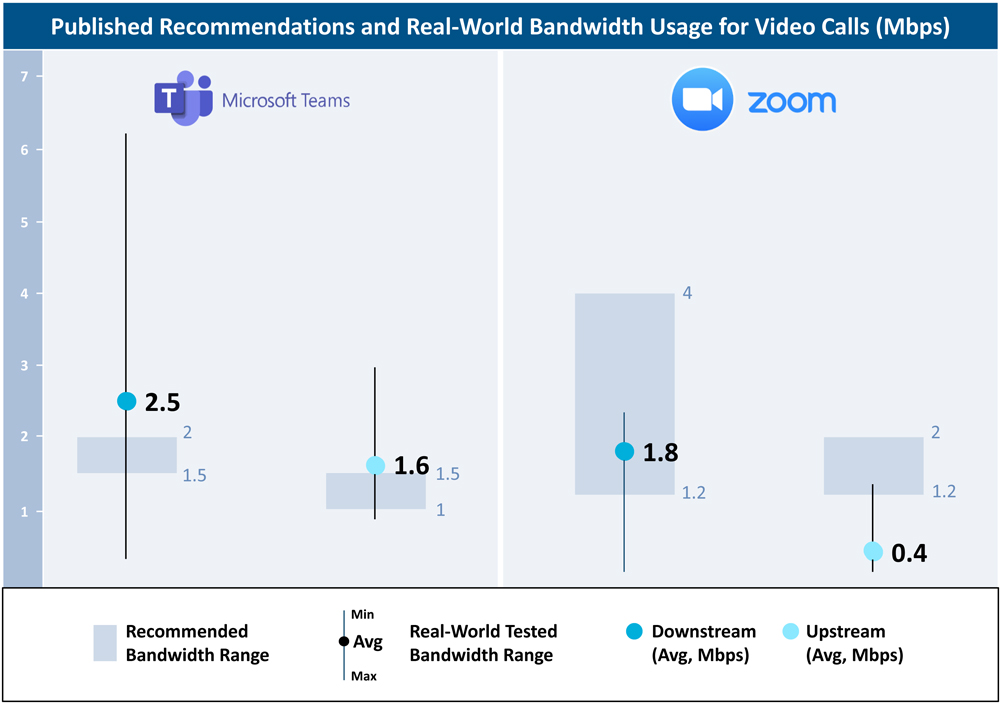Video Conferencing Applications: Bandwidth Benchmarking
By Radhika Shivaprasad, Megan Corriveau, Heather Sabel, Samuel Kornstein, Rishi Modha
Before the pandemic, 20% of Americans worked from home. Now, 71% do, and 81% of employed Americans working from home report relying on video conferencing services to continue doing their jobs[i]. Clearly, COVID-19 has greatly increased the importance of video conferencing applications in our lives.
The video conferencing market is expected to nearly double in market value from $4.8 billion in 2019 to $9.2 billion by 2026[ii], largely driven by the accelerated adoption of video conferencing that occurred during the pandemic. The leading video conferencing applications are all benefitting from this growth, for example:
- Zoom reported over 300 million users in Q3 2020, compared with 10 million in December 2019[iii]
- Microsoft Teams reported 75 million daily active users in Q3 2020, compared with 20 million in November 2019[iv]
- Google Meets reported a thirty-fold increase in users from January 2020 to April 2020[v]
This increased use of video conferencing applications has likely increased typical household internet bandwidth needs. To better understand the implications of this trend, we gathered the bandwidth requirements for two common video conferencing applications, Zoom and Teams, and then compared these requirements to the results of a series of bandwidth measurement tests we completed.
Top video conferencing applications are relatively bandwidth efficient, both in published requirements and real-world performance tests

Two of the most common applications, Zoom and Microsoft Teams, report that they require 1-4 Mbps downstream and 1-2 Mbps upstream. Performance in real-world tests was similar to reported requirements.
Bandwidth requirements are greater when video resolution is greater (e.g., HD quality), and for group calls relative to 1:1 calls. For example, Zoom recommends 4 Mbps downstream for group video calls, versus only 1.2 Mbps downstream for 1:1 video calls.
In our tests, Microsoft Teams’ average bandwidth consumption fell slightly higher than the recommended range, with some peaks – or maximum bandwidth consumed during the test – that were quite a bit higher than the recommendation.
Zoom’s average bandwidth consumption was more efficient than the recommendation, and the bandwidth consumed throughout the duration of the test also stayed below or towards the very bottom of the range.
Overall, both applications performed well with moderate bandwidth consumption relative to typical speeds available to consumers.<>
At Cartesian, we help providers conduct competitive assessments across a range of products and services. Our data-driven approach combines analytics and strategy to help providers understand their position relative to the market and identify key opportunities to improve. Contact us to see how we can help you assess your position in the market and develop future growth strategies.
[i] “How the Coronavirus Outbreak Has and Hasn’t – Changed the Way Americans Work”, Pew Research Center, December 2020
[ii] Video Conferencing Market, FNF Research, October 2020
[iii] “90-Day Security Plan Progress Report: April 22”, Zoom, April 2020
[iv] “Microsoft Teams hits 75 million daily active users, up from 44 million in March”, Windows Central, April 2020
[v] “Google’s Meet teleconferencing service now adding about 3 million users per day”, The Verge, April 2020




